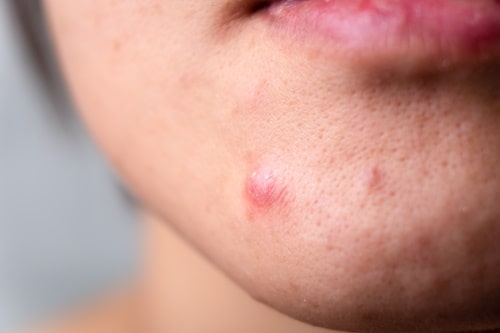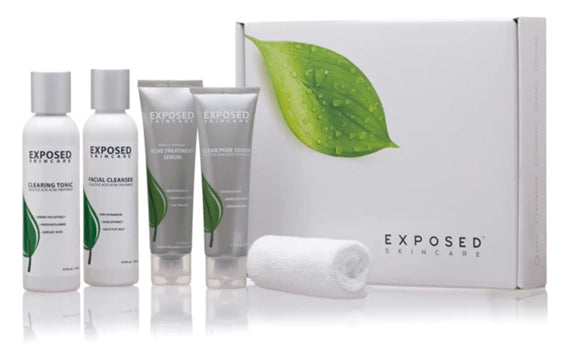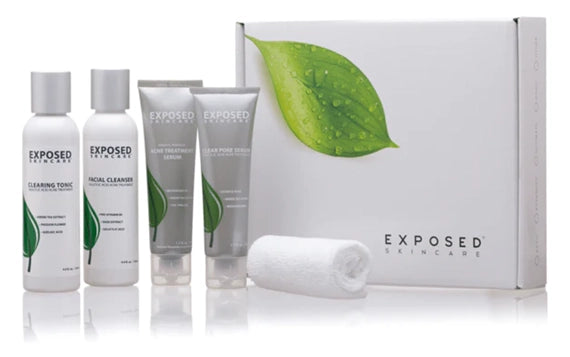Acne has a history as long as mankind. This pesky skin disease has puzzled and troubled us from ancient times to today. This blog post will traverse the history of acne, going back to its earliest recorded instances and tracing its evolution as a treatable condition.
This article dives into the different treatments and viewpoints that have characterized its long history, offering a panoramic view of how our understanding and treatment of acne have evolved.
Also read: How to choose the best acne treatment
Biggest Take-Aways:
- The history of acne is extensive and dates back to ancient times, but modern understanding views it as a multifaceted disease with various contributing factors.
- Advances in science have led to a range of effective treatments for acne and related skin conditions like rosacea.
- Hormones like androgens play a crucial role in the development and severity of acne, particularly during periods like puberty.
- Exposed Skin Care offers a comprehensive solution for treating acne, targeting multiple aspects, from sebum production to inflammation, with its unique blend of ingredients.

The Ancient Roots of Acne
The history of acne stretches back to ancient civilizations, where people had different beliefs and remedies for this skin condition. Let's explore some of these initial thoughts and treatments.
The Egyptians: More than Just the Pyramids
The Egyptians, known for their advancements in various fields, also had to deal with acne. Though their understanding of the disease of the skin was rudimentary, their treatments involved topical applications made from honey and salt.
Greeks and Romans: Philosophical About Spots
In Ancient Greece and Rome, acne was often attributed to diet or lifestyle choices. Early writings recommend avoiding certain foods that were thought to worsen the condition.
Asian Traditions: A Holistic Approach
In ancient China and India, herbal remedies and holistic treatments were common. The Chinese linked the presence of acne to imbalances in Yin and Yang, while Ayurvedic medicine in India incorporated natural ingredients like turmeric and neem into their treatment regimens.

The Medieval Era: A Dark Age for Acne
The Middle Ages were a tough time, not only for civilization but also for advancements in treating acne. Let's look at the prevalent beliefs and treatments during this period.
Witchcraft and Bad Air
People often associated acne and other skin conditions with witchcraft or evil spirits during these times. Treatments were generally ritualistic and not based on any form of scientific understanding.
Introduction of Sulfur
Although the Dark Ages were not conducive to medical advancements, sulfur was introduced as a topical treatment for acne during this period. This was one of the first instances of an element explicitly used for treating acne vulgaris.
The Renaissance to Modern Times: Science Takes Over
This era marked the beginning of a scientific approach to understanding acne. New treatments were developed, and more comprehensive research shaped our understanding of acne pathogenesis.
18th Century: Classifying Acne
During the 18th century, the British dermatologist Robert Willan first attempted to classify acne. He categorized different forms of acne into four types: simple acne, acne indurata, acne rosacea, and acne conglobata.
19th Century: An Age of Discovery
By the 19th century, advancements in technology made it possible to study the skin at a microscopic level. This led to the discovery of the sebaceous gland, which plays a key role in sebum production and acne pathogenesis.
20th Century: Rise of Pharmaceuticals
The 20th century saw the development of pharmaceuticals designed explicitly for acne treatment. Antibiotics, hormones, and later, isotretinoin, began to play a crucial role in acne management.

Modern-Day Treatment: A Blend of Tradition and Science
Today, treatment for acne combines traditional methods with scientific research, making it more effective than ever.
Topical Treatments: From Ointments to Serums
Today's topical treatments are a far cry from the rudimentary pastes used in ancient times. Modern ointments and serums are designed to target specific issues such as inflammation, acne lesions, and acne scars.
Holistic Approaches: From Diet to Lifestyle
Modern-day treatment also involves a comprehensive lifestyle approach. Stress management, proper diet, and maintaining a healthy skin surface are vital alongside medical procedures for effective acne treatment.
The Role of Research: Uncovering New Pathways
Research into the prevalence, aetiology, pathogenesis and treatment of acne is a continually evolving field. Recent studies focus on everything from hormonal imbalances to the influence of diet, paving the way for more personalized acne treatment options.
Genetic Factors
Studies have shown that acne can run in families, hinting at a genetic predisposition. This has led to research into the specific genes involved in sebaceous glands and sebum production.
Environmental Impact
With the rise in skin conditions, including acne, studies are increasingly looking into the effects of pollution and other environmental factors on our skin.

The Cultural Impact of Acne: More than Just Skin-Deep
The history of acne is not just medical; it's cultural. Acne has been stigmatized and often misunderstood throughout history, affecting millions psychologically and socially.
Stigmatization and Misunderstanding
In various cultures, acne is often misunderstood as a disease associated with poor hygiene or an unhealthy diet. This has led to stigmatization and can have a profound impact on self-esteem.
Impact on Women
Acne affects women differently, particularly women of childbearing age. The prevalence of acne among adult women has led to research into how hormonal changes affect the skin, especially during reproductive age.
Media and Acne
The way acne is portrayed in media also impacts societal perceptions. While makeup and filters can hide acne on screen, they set unrealistic expectations, further contributing to the stigma around this common skin condition.
Modern Solutions: The Benefits of Using Exposed Skin Care in Managing Acne
Scientific understanding of diagnosis and treatment methods has greatly improved. Thus, managing acne has become significantly easier. One such leap in the development of acne management is Exposed Skin Care, an effective range of products designed to tackle acne head-on.
Here are the benefits of Exposed Skin Care:
- Treatment of Acne Vulgaris and Rosacea: Exposed Skin Care products are highly effective in treating various skin conditions, including acne vulgaris and rosacea.
- Targeting the Follicle: The Treatment Serum and Clearing Tonic directly target the follicles where acne starts, thereby reducing the formation of comedones and papules.
- Removal of Dead Skin Cells: The Derm-X Cloth and Microderm Scrub effectively removes dead skin cells, reducing the risk of acne breakouts.
- Addresses Different Life Stages: Whether dealing with postadolescent acne, adult acne, or acne during puberty, Exposed Skin Care offers a range of products suitable for all life stages.
- Reducing Scarring: Unmistakable scars and inflamed acne lesions are significantly reduced, offering a solution for long-standing skin or acne issues.
This comprehensive, practical treatise of Exposed Skin Care as a treatment method demonstrates its effectiveness in tackling various facets of acne. It's a contemporary take that respects both the complex history and current facts recorded in acne management.
Conclusion
The history of acne has been a long and intricate journey, from ancient descriptions to modern medical understanding. Although acne, especially severe acne and facial acne vulgaris, has been the bane of many, scientific advances have provided us with a nuanced understanding of the disease of the pilosebaceous unit.
Androgen-related imbalances, the formation of acne, and the treatment of certain cutaneous conditions are now better understood, offering hope to patients with acne. Contemporary treatments have emerged as applicable in treating various skin diseases, including acne and rosacea.
While the journey is far from over, progress has been made in leaps and bounds. From treatments like isotretinoin for active acne to advances in reducing the risk of radiation-induced skin cancer, the future looks promising.
One such reliable resource is Exposed Skin Care, which has proven highly effective in treating acne. Its unique blend of scientific and natural ingredients targets multiple aspects of acne, from reducing pustules to regulating sebum production.
In sum, acne has come a long way from how it was written about in ancient times. Today's advances in understanding and treatment offer hope and effective solutions for those struggling with this enduring skin issue.
FAQs
What is acne?
Acne is a skin condition that occurs when hair follicles become clogged with oil and dead skin cells, forming pimples, blackheads, and whiteheads.
How has the understanding of acne evolved over time?
The understanding of acne has evolved significantly from ancient times, where it was considered a curse, to the modern understanding of it as a disease of the pilosebaceous unit with various contributing factors.
What are some common treatments for acne and rosacea?
Common treatments include topical creams, antibiotics, and sometimes, isotretinoin. Different treatments target sebum production, inflammation, and bacterial infection.
What role do hormones play in acne?
Hormones like androgens can trigger acne by increasing sebum production. This is often seen during puberty and in women with hormonal imbalances.
What is Exposed Skin Care?
Exposed Skin Care is a range of skincare products designed to treat acne and improve overall skin health effectively. Its products contain a blend of scientific and natural ingredients targeting multiple aspects of acne.
















